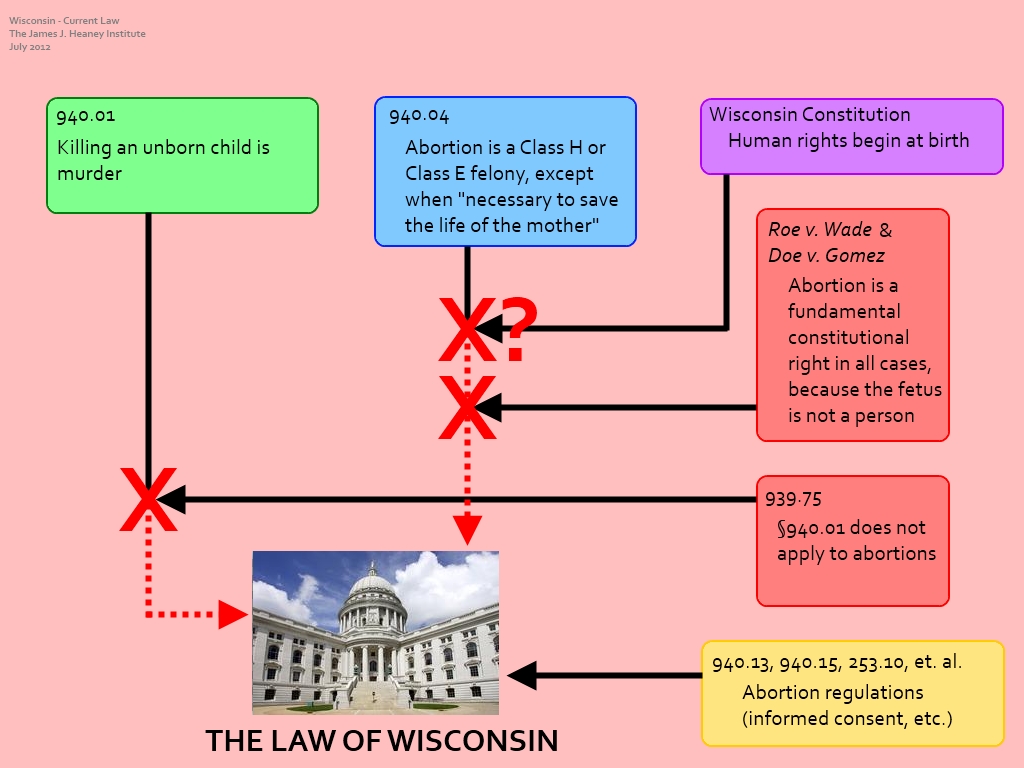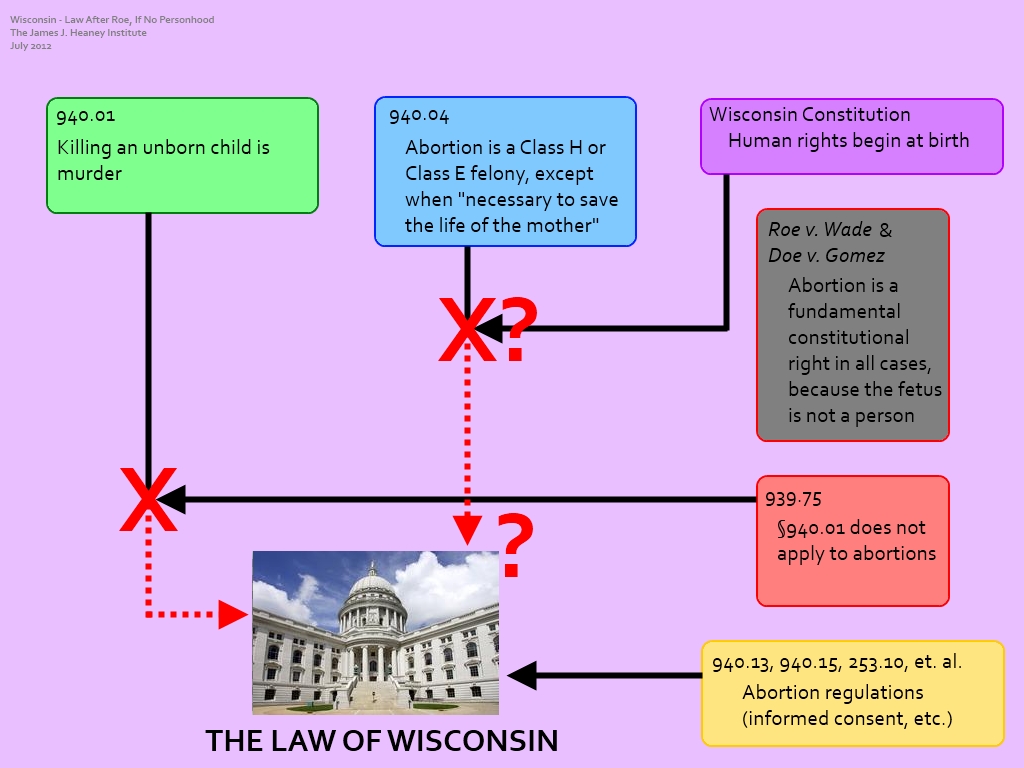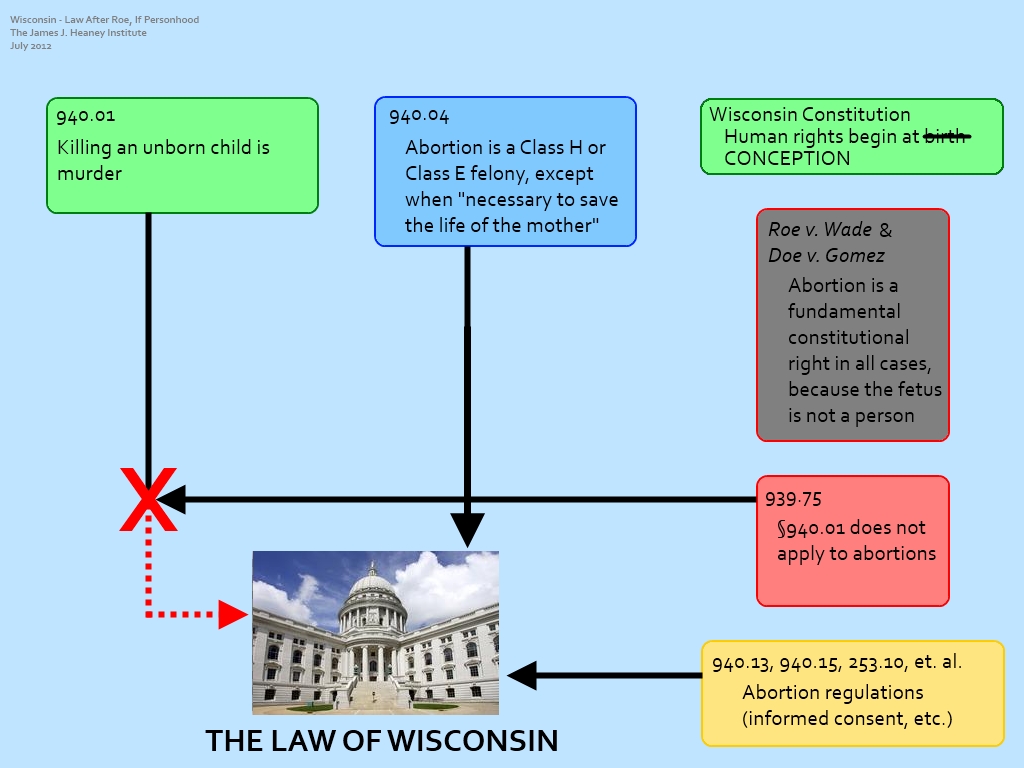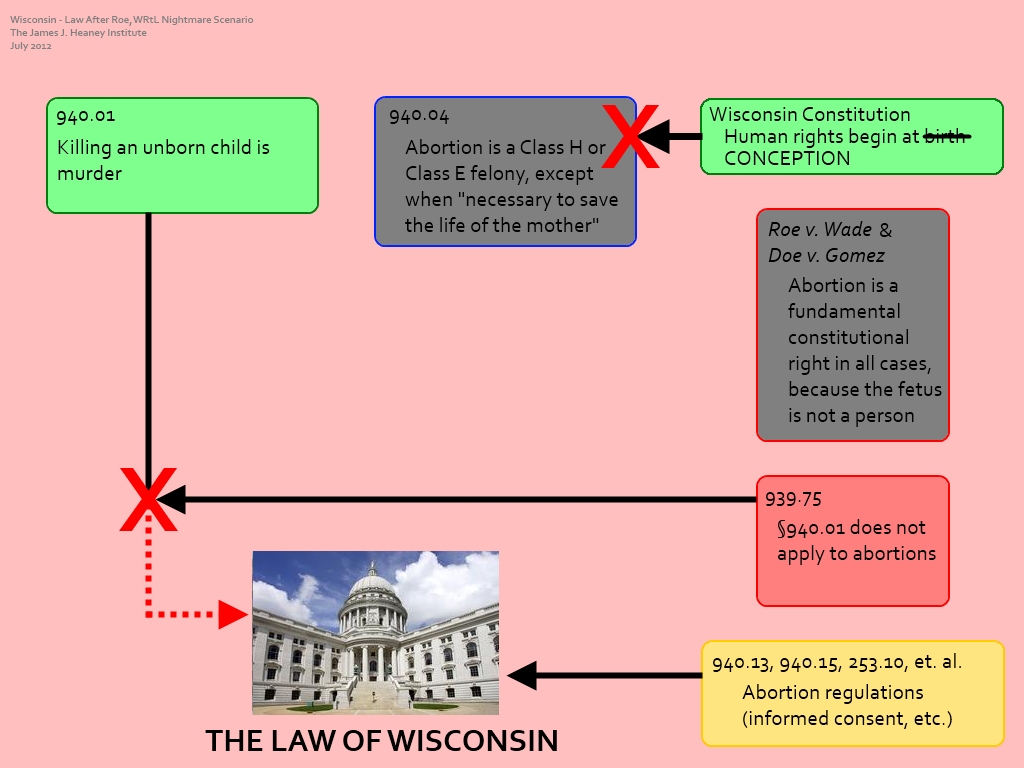If you have not read my introduction to the Wisconsin Personhood initiative, please read that first.
You might also wish to read the second article in this series, which discussed Wisconsin Right-to-Life’s public claims about the Personhood Amendment. We now move on to its non-public claims.
This third post about Personhood Wisconsin is a lot more technical than the first two. It’s also a lot longer. It has no funny pictures. I am assuming that you are, by this point, familiar with the basic terrain, and that you know my feelings about the groups involved, so I will not restate them. Instead, I will dive right in.
Here’s the TLDR: Wisconsin Right-to-Life’s lawyers rely on a peculiar combination of unlikely presumptions and studied indifferences in order to reach their conclusion opposing the Personhood Amendment. Their white paper consistently presumes all the risks of a Personhood Amendment, no matter how unlikely, and studiously ignores or dismisses both the rewards of Personhood and at least one obvious counter-argument to their major claim. For these reasons, I consider its conclusions unreasonable. Wisconsin unborn children will be best protected by passing a Personhood Amendment, rather than leaving them to an uncertain future under the vulnerable pre-Roe statute currently on the books. That’s the long and short of it. If you are not feeling up to an extensive nitpicking of a fourteen-page legal opinion, you can leave now.
Still with us? Welcome aboard. I’ll reward you with the joke I promised in the title:
Q: Did you hear the one about the word processor for lawyers?
A: No, I didn’t. Why are you even talking to me? Who are you?
Q: No matter what font you select, everything comes out in fine print!
Q makes a good point: just because a lawyer is saying something at great length, citing his sources and making great sense as he goes, does not mean he is saying anything of relevance or, indeed, of interest. It will be helpful to bear this in mind as you read through Wisconsin Right-to-Life’s white paper with me. Which reminds me, I had better go ahead and post a copy for you to read:
WRtL 2011 Personhood White Paper, aka:
Wisconsin’s Pre-Roe v. Wade Abortion Statute: Current Status and Potential Threats Related to 2011 AJR 77, A Proposed Amendment to the State Constitution. Published by Wisconsin Right-to-Life, Milwaukee, WI, in January 2012.
I’m not certain why I, of all people, am the first person to put this up online, but I made it clear in my communication with Wisconsin Right-to-Life that I intended to discuss any reply they sent me on my blog, and they raised no objection. So here it is. Please read along with me, especially if you are a bona fide lawyer, and call me on it if you see me taking any liberties with the text Wisconsin Right-to-Life presented to me. Throughout the rest of this post, I will refer to this document as “the white paper” and its authors as “James Bopp et al.”. Bopp is both the first-listed author and, by all accounts, the principal author of the text, although it has sixteen other signers. All are lawyers, some, like Clarke Forsythe and Rick Esenburg, well-known to pro-lifers in and out of Wisconsin. I quail to question any document with such names attached to it, and I freely admit my “legal training” consists of two honors classes in undergrad and a penchant for reading judicial decisions. I would hate to put all this work into arguing that Bopp et al. are wrong only to have myself proved wrong by Bopp et al. Nevertheless, if I am wrong, I hope that they will swiftly correct me in the spirit of pro-life fraternity. I will, of course, post any response they or anyone associated with Wisconsin Right-to-Life sends me, regardless of whether or not I find that reply persuasive.
Having disclaimed myself, let’s get to legal matters. I’ll start by mentioning a few pieces of Wisconsin law, which I will use throughout this piece without further explanation:
Article I, Section 1 (equal protection clause): Section of the Wisconsin Constitution that guarantees equal rights to all persons (link). Currently implies that personhood begin at birth, not conception. Personhood would amend this section to clarify that human rights begin at the beginning of human life – that is, conception (link).
Section 940.04 (“Abortion” law): This is Wisconsin’s pre-Roe anti-abortion statute (link). As discussed in the previous post, it is not perfect, and it is currently unenforceable because of Roe v. Wade. If Roe were ever overturned, Section 940.04 would immediately come back into force.
Section 940.01 (“Murder” law): This is Wisconsin’s murder statute (link). Interestingly, Wisconsin’s murder statute specifically mentions that killing an unborn child is murder, legally equivalent to any other murder. Taken by itself, Section 940.01 says that abortion is, literally, murder.
Section 939.75 (abortion-not-murder law): This statute (link) states that a legal, surgical abortion with the mother’s consent is not murder. Its main purpose is to create an exception to the abortion-is-murder formula in Section 940.01 (and several other parallel sections).
Section 940.13 (maternal immunity law): This law (link) states that a mother can never be prosecuted for an abortion; only the abortionist who performs the surgery can be punished for the crime.
Section 940.15: Wisconsin’s post-Roe abortion statute (link). Restricts abortion as much as the Supreme Court allows, which is not very much. If Roe were overturned, it would be superseded by 940.04.
Abortion regulations: There are various other abortion laws in Wisconsin, like 940.16 (banning partial-birth abortion), 253.10 (informed consent and waiting period), and 20.927 (restricting state funding of abortions). I refer to them collectively (along with 940.13 and 940.15) as Wisconsin’s abortion regulations, since they regulate abortion but do not significantly restrict it. They are going to remain on the books whether Personhood passes or not, so I won’t discuss them very much.
Roe v. Wade & Doe v. Bolton: A pair of 1973 Supreme Court decisions which, taken together, created a virtually unlimited right to abortion throughout the country (link and link). Roe depends on the court’s finding that the unborn child is not a person – at least not for the purposes of the U.S. Constitution. (The white paper also discusses Babbitz v. McCann, a lower-court series of cases from the early 1970s, similar to Roe v. Wade but specifically about Wisconsin law. Babbitz – which began before Roe was handed down – initially ruled 940.04 unconstitutional, but later had that ruling suspended. It was still in progress when Roe rendered the entire case moot, or no longer relevant, and the case died. I do not dispute any of the white paper’s claims about Babbitz or its companion, Larkin, and so we will not discuss them much here, if at all.)
Now, I know I just threw a lot of conflicting statutes at you without giving you a big picture of how they all fit together. So… here’s the big picture! This chart represents the CURRENT LAW OF WISCONSIN, as of July 2012:
As you can see, while Roe remains the chief obstacle to anti-abortion law in Wisconsin, there is another big threat on the horizon: the Wisconsin Constitution could kill 940.04. This is probably the most important point in my entire discussion, so I’ll state it again: even without Roe v. Wade in the way, the Wisconsin Constitution could kill Wisconsin’s primary law against abortion.
Bopp et al. spend the first half of their white paper (yes, half) discussing a point which is almost totally uncontroversial: they insist, stridently, that Section 940.04 has not yet been repealed or enjoined. This means that, if Roe were overturned by the Supreme Court, Section 940.04 would come immediately into effect; there would be no need to pass further laws or win further court cases to put Wisconsin’s abortion law back in play. This is very probably true, and no major player in the debate has, to my knowledge, disputed it — even Planned Parenthood agrees. The only group to raise this question, the non-partisan Wisconsin Legislative Council, did so in a single throwaway line at the end of their Personhood analysis. Nevertheless, Bopp et al. painstakingly construct a fireproof legal argument proving that 940.04 would go back into effect the day after Roe is thrown on the ash heap of history. You can read it yourself, if you like. I’m happy to agree with all of it.
The problem is what happens after somebody actually gets arrested for performing an abortion. That abortionist is going to go to court, and is going to try to prove that, even if the U.S. Constitution doesn’t guarantee the right to an abortion, the Wisconsin Constitution does. Unfortunately, the equal protection clause of the Wisconsin Constitution, and the undeniable possibility of activism among Wisconsin’s most powerful judges, this challenge is at least somewhat likely to succeed. Section 940.04 would be overturned, and abortions in Wisconsin would resume as if Roe were still in effect.
Don’t just take my word for it. Here are the words of a prominent pro-life lawyer, writing back in 2007 [bold emphasis mine]:
An equal protection justification for the declared abortion right was advocated by attorneys for the Planned Parenthood Federation and the ACLU in Webster v. Reproductive Health Services. 492 U.S. 490 (1989). It has also been advocated by Harvard Law School Professor Laurence Tribe, among others. See, e.g. Laurence Tribe, American Constitutional Law 1353 n.109 (2d ed. 1988). While an argument can be made that the equal protection clause provides no basis for a right to abortion, see Bopp, Will There Be a Constitutional Right to Abortion After the Reconsideration of Roe v. Wade?, 15 J. Contemp. L. 136-41, now-Justice Ginsburg has argued that the equal protection clause provides a justification for an abortion right that is superior to the analysis employed in Roe. See Ruth Bader Ginsburg, Some Thoughts on Autonomy and Equality in Relation to Roe v. Wade, 63 N.C. L Rev. 375 (1985). And as noted above, four dissenting justices in Gonzales have now joined her position. Were the Court to embrace her view that the equal protection clause protects the right to choose abortion on the basis of gender discrimination (in a majority opinion, or even in a plurality opinion), states would likely have to fund abortions that they are not currently required to fund in programs for indigent persons. This has happened in some states that passed an equal rights amendment (which has a similar analytical effect to adopting an equal protection rationale for abortion rights). See, e.g., Fisher v. Dept. Pub. Welfare, 482 A.2d 1137 (1984), rev’d, 502 S.2d 114 (Pa. 1985); Maher v. Roe, 515 A.2d 134 (Conn. Super. Ct. 1986).
The pro-life lawyer who wrote that is James Bopp, in his widely-read memo arguing against some earlier, more aggressive, versions of the Personhood Amendment in other states. It is curious that he does not appear to notice its application in favor of Personhood in Wisconsin 2012.
The bottom line is pretty clear: states that explicitly grant a constitutional right to equal protection, but do not explicitly grant constitutional rights to the unborn, are highly vulnerable to a rogue judiciary establishing a state-level constitutional right to abortion – and perhaps even rolling back existing anti-abortion laws. Indeed, some state Supreme Courts have “found” a right to abortion in their state constitutions on much thinner pretexts (e.g. Minnesota: Doe v. Gomez (1995); New Jersey: Right to Choose v. Byrne (1982)) than Wisconsin’s Constitution provides. This would be all the more true in a post-Roe judicial challenge, with liberal activists desperate to find some way to justify continuing the legal abortion regime. Wisconsin is not just one of many states in danger: with its “born free and equal” language, it is more vulnerable to this analysis than almost any other state in the nation. There is a significant possibility that Section 940.04 would be overturned, with fatal consequences for the unborn. Here is WISCONSIN LAW AFTER ROE ENDS, represented graphically:
Personhood, however, would block the equal protection argument for abortion by amending Article I, Section 1 to clarify Wisconsin’s recognition of unborn rights. This is the strongest argument for passing the Personhood Amendment. It is the key claim made by Personhood Wisconsin on their website and in the initiative’s memo to Wisconsin legislators: “An activist Wisconsin Supreme Court could someday use this provision [the equal protection clause] to deny the right to life of the preborn by interpreting an independent right to abortion in our state constitution. In so doing, the court could nullify any present or future pro-life laws in our state… Only by enshrining the right to life in our state constitution will preborn children be afforded full and lasting legal protection.”
In response to this, the core argument of Personhood backers, the Wisconsin Right-to-Life white paper says… nothing whatsoever. I have nothing to respond to; the space Bopp et al. should have been spent discussing Section 940.04’s survival in the post-Roe environment was instead spent litigating the issue of “implied repeal,” which nobody in the Wisconsin abortion debate has contested. Then, they discuss the possibilty and likely outcomes of a federal court case against Personhood under Roe, which is, again, not relevant to the post-Roe world, and with which I, again, completely agree (see my simplified discussion of a direct challenge under Roe all the way back in Part I).
So, without further ado, this is PERSONHOOD WISCONSIN’S VISION of Wisconsin immediately after Roe, if the Personhood Amendment has been passed:
Abortion would be treated as a minor felony, with a life-of-the-mother exception. This would outlaw more than 99% of abortions. For Wisconsin Right-to-Life, this may, in fact, constitute a total victory.
Of course, for abortion abolitionists, this would not be the end of the road. As I stated in my first post, our object is twofold: (1) to have the deliberate and directly intended killing of any human being at any stage of development universally condemned as murder, and (2) to institute a humane medical system that treats both mothers and their children as patients. Because of the legal complexities surrounding “life-of-the-mother” exceptions, 940.04 does neither – but it is, without a doubt, a fantastic start, and a tremendous leap forward from where the Wisconsin pro-life movement stands today. Personhood supporters and Wisconsin Right-to-Life all agree: we want Section 940.04 in force following the death of Roe. The Personhood Amendment, at first blush, appears to ensure that.
Wisconsin Right-to-Life’s chief fear is that there is a risk (a modest risk, Bopp et al. acknowledge, but a risk) the Personhood Amendment would actually injure 940.04. This is their core argument in both the white paper and the web site. As Bopp et al. put it in their executive summary, “The language of the proposed amendment would create a material risk of Wisconsin’s pre-Roe criminal abortion statute [Section 940.04] being declared unconstitutional under the Wisconsin Constitution.” How could this be? Well, turn to page 12 of your copy of the white paper:
The proposed amendment says that the inherent rights of all people include the right to life. Is the right to life part of the freedom that unborn children share equally with everyone else? If so, does the fact that it is shared “equally” mean that the legal protection of that right provided by the criminal law must be the same for unborn children as it is for everyone else? If the answers to these questions are “Yes,” then prescribing a lesser penalty for intentionally and deliberately killing a child three months before birth than for intentionally and deliberately killing a child sixty minutes after birth – which is one of the effects of §904.04 – would conflict with that prescription.
Let me restate that a little bit, for non-lawyers: Wisconsin’s combined murder laws (940.01 plus 939.75) make murder of a born person a Class A felony, with a penalty of life imprisonment. Wisconsin’s abortion statute makes the murder of an unborn person, with the mother’s consent, only a Class E felony – at most – which carries a penalty of up to 15 years in prison. Since, right now, unborn people have no recognized rights under Wisconsin law, it is legal for abortion to be a lesser crime than murder.
If Wisconsin passed Personhood, that would change. Suddenly, unborn people would have rights under the law – rights that are theoretically equal to those of born people! This would give the opportunity for abortion supporters to sue.
After all, what if Wisconsin had a law saying that murdering a man is a Class A felony, but murdering a woman is only a Class E felony? Or what if it had a law that sentenced you to 25-to-life for murdering a white, but only made you pay a $10,000 fine for murdering a black? It would be a horrible injustice, obviously! But, more importantly, it would be a violation of the Wisconsin Constitution, which says that “all people are born equally free and independent,” entitling all of them to the equal protection of the laws. Since Section 940.04 treats the unborn unequally, assigning a lower “value” to them under Wisconsin’s homicide laws, a court could use Personhood to strike down 940.04 as unconstitutional.
If 940.04 alone is struck down, Wisconsin would be stripped of its pre-Roe anti-abortion statute… and, when Roe finally ended, there would be no protection for the unborn under Wisconsin law, all thanks to the voters’ decision to pass Personhood. This is Wisconsin Right-to-Life’s NIGHTMARE SCENARIO:
Now, Wisconsin Right-to-Life acknowledges that this scenario is not likely. They are right to do so; non-partisan observers agree that it isn’t. Planned Parenthood and its allies would have to overcome several obstacles to pull this off. First, they would have to prove standing, which is a legal term meaning you have to show that you, personally, have actually been harmed by a law or person before you are allowed to sue that law or person. Then, they would deal with the fact that Wisconsin law already treats some murders different than others. For example, Bopp et al. write, “Murder for hire… is punished more harshly than murder committed impulsively at the climax of a heated argument. Judges would ask the challengers why the differentiation implicit in §940.04 is not simply one more example of this commonplace approach.” Third… well, I’ll get to that later. The white paper lists only those first two, and concludes ominously:
[The case] might fail – but it might succeed. Its prospects for success are certainly not trivial. And if it did succeed, the results would be literally fatal for thousands of unborn children in Wisconsin.
It’I hope that the Nightmare Scenario scares you, dear reader. If so, then I have done justice to Wisconsin Right-to-Life’s position. That liberates me to discuss why I find that position totally unpersuasive.
The first problem with the analysis by Bopp et al. is that is so one-sided. Let us suppose the legal team here is completely correct: passing Personhood would create a material risk that 940.04 would be struck down, preventing it from going into effect in the post-Roe world. Even insofar as that’s true, it ignores the reverse: failing to pass Personhood also entails a material risk that 940.04 would be struck down! We discussed this earlier. Personhood is designed, in large part, to protect Section 940.04 from challenges under the Wisconsin Constitution in post-Roe Wisconsin. Those challenges, to borrow a phrase, might fail – but they might succeed. Their prospects for success are certainly not trivial!
So, even if we assumed that the white paper’s analysis is correct, it would not the end of the discussion. Rather, it would be the beginning of a new, critically important discussion: would it be it safer to pass Personhood and trust the courts not to abuse it to strike down anti-abortion laws? Or would it be safer to leave the Wisconsin Constitution as it is and trust the courts not to abuse it to strike down anti-abortion laws? This would not be an easy question to answer. The judges who rule our nation are nothing if not capricious. We all saw just last month how, even after months of analysis and speculation, every single legal expert in the nation got their prediction wrong in NFIB v. Sebelius (aka the Obamacare case). There is probably a case to be made for either side of the question. For my money, I think 940.04 is in considerably more danger without Personhood than it would be with Personhood. But, hey, I’m no lawyer. Unfortunately, Wisconsin Right-to-Life does not devote one scintilla of ink to this question, so the arguments of their lawyers are not available to us. The claims coming from Personhood Wisconsin (and its own bag o’reputable pro-life lawyers) about the risk of a constitutional challenge to 940.04 stand unanswered.
I could end my analysis here. I believe I have made a compelling case that Wisconsin Right-to-Life’s case against Personhood relies on a succession of unlikely speculations about the legal fate of Personhood. This speculation is wrapped, in turn, in a thick layer of obfuscatory arguments, which aim to prove points that everyone in the debate already admits. Against all this, Bopp et al. practice a studied indifference to a major threat to Wisconsin’s post-Roe abortion law in the form of the Wisconsin state Constitution – in spite of the fact that this threat forms the strongest reason put forward by Personhood Wisconsin in favor of the Amendment. The white paper is incomplete at best. I have shown that, while there are some risks associated with passing a Personhood Amendment (including the Nightmare Scenario), these risks are balanced against other risks (in my opinion, greater risks) associated with not passing a Personhood Amendment. I have shown, in short, that a rational Wisconsin pro-lifer can – and probably should – support the Personhood Amendment. At any rate, even when we assume that the white paper’s analysis of the Nightmare Scenario is basically correct, Wisconsin Right-to-Life’s active work in opposition to the Personhood Amendment appears to be an unjustifiable disservice to the pro-life community of Wisconsin. If that conclusion satisfies you, you can stop reading now.
However, I don’t think that’s going far enough. I do not believe the Nightmare Scenario is nearly as likely as Wisconsin Right-to-Life believes it to be. The white paper does not merely ignore the benefits of the Personhood Amendment; I believe it significantly exaggerates the risks. Given the sterling credentials of its authors, this exaggeration is no doubt inadvertent. Nevertheless, if I am correct, it becomes very difficult – perhaps impossible – to rationally defend a pro-lifer’s opposition to the Personhood measure in Wisconsin.
That brings us to the end of this post. You may have noticed that I promised five graphics in the title, but there were only four. That’s because graphic #5 is coming up in my next and (I’m serious this time!) final post, where I will discuss my contention that the white paper gets the risks of Personhood wrong.




